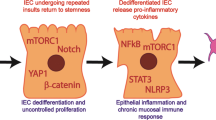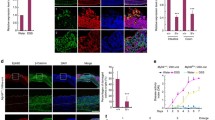Abstract
Su (var) 3–9, enhancer of seste, trithorax (SET)-domain bifurcated histone lysine methyltransferase (SETDB1) plays a crucial role in maintaining intestinal stem cell homeostasis; however, its physiological function in epithelial injury is largely unknown. In this study, we investigated the role of SETDB1 in epithelial regeneration using an intestinal ischemia/reperfusion injury (IRI) mouse model. Jejunum tissues were sampled after 75 min of ischemia followed by 3, 24, and 48 h of reperfusion. Morphological evaluations were performed using light microscopy and electron microscopy, and the involvement of SETDB1 in epithelial remodeling was investigated by immunohistochemistry. Expression of SETDB1 was increased following 24 h of reperfusion and localized in not only the crypt bottom but also in the transit amplifying zone and part of the villi. Changes in cell lineage, repression of cell adhesion molecule expression, and decreased histone H3 methylation status were detected in the crypts at the same time. Electron microscopy also revealed aberrant alignment of crypt nuclei and fusion of adjacent villi. Furthermore, increased SETDB1 expression and epithelial remodeling were confirmed with loss of stem cells, suggesting SETDB1 affects epithelial cell plasticity. In addition, crypt elongation and increased numbers of Ki-67 positive cells indicated active cell proliferation after IRI; however, the expression of PCNA was decreased compared to sham mouse jejunum. These morphological changes and the aberrant expression of proliferation markers were prevented by sinefungin, a histone methyltransferase inhibitor. In summary, SETDB1 plays a crucial role in changes in the epithelial structure after IRI-induced stem cell loss.







Similar content being viewed by others
Data availability
Original micrographs and any other information are available upon request from the corresponding author.
References
Acosta S (2010) Epidemiology of mesenteric vascular disease: clinical implications. Semin Vasc Surg 23(1):4–8. https://doi.org/10.1053/j.semvascsurg.2009.12.001
Ali MN, Choijookhuu N, Takagi H, Srisowanna N, Nguyen Nhat Huynh M, Yamaguchi Y, Synn Oo P, Tin Htwe Kyaw M, Sato K, Yamaguchi R, Hishikawa Y (2018) The HDAC inhibitor, SAHA, prevents colonic inflammation by suppressing pro-inflammatory cytokines and chemokines in DSS-induced colitis. Acta Histochem Cytochem 51(1):33–40. https://doi.org/10.1267/ahc.17033
Barker N, van Es JH, Kuipers J, Kujala P, van den Born M, Cozijnsen M, Haegebarth A, Korving J, Begthel H, Peters PJ, Clevers H (2007) Identification of stem cells in small intestine and colon by marker gene Lgr5. Nature 449(7165):1003–1007. https://doi.org/10.1038/nature06196
Batham J, Lim PS, Rao S (2019) SETDB-1: a potential epigenetic regulator in breast cancer metastasis. Cancers 11(8):1143. https://doi.org/10.3390/cancers11081143
Cao N, Yu Y, Zhu H, Chen M, Chen P, Zhuo M, Mao Y, Li L, Zhao Q, Wu M, Ye M (2020) SETDB1 promotes the progression of colorectal cancer via epigenetically silencing. p21 expression. Cell Death Dis 11(5):351. https://doi.org/10.1038/s41419-020-2561-6
Choijookhuu N, Sato Y, Nishino T, Endo D, Hishikawa Y, Koji T (2012) Estrogen-dependent regulation of sodium/hydrogen exchanger-3 (NHE3) expression via estrogen receptor β in proximal colon of pregnant mice. Histochem Cell Biol 137(5):575–587. https://doi.org/10.1007/s00418-012-0935-2
Devkota K, Lohse B, Liu Q, Wang MW, Stærk D, Berthelsen J, Clausen RP (2014) Analogues of the natural product Sinefungin as inhibitors of EHMT1 and EHMT2. ACS Med Chem Lett 5(4):293–297. https://doi.org/10.1021/ml4002503
Eltzschig HK, Eckle T (2011) Ischemia and reperfusion–from mechanism to translation. Nat Med 17(11):1391–1401. https://doi.org/10.1038/nm.2507
Febres-Aldana CA, Alghamdi S, Krishnamurthy K, Poppiti RJ (2019) Liver fibrosis helps to distinguish autoimmune hepatitis from DILI with autoimmune features: a review of twenty cases. J Clin Transl Hepatol 7(1):21–26. https://doi.org/10.14218/JCTH.2018.00053
Friedrich M, Gerbeth L, Gerling M, Rosenthal R, Steiger K, Weidinger C, Keye J, Wu H, Schmidt F, Weichert W, Siegmund B, Glauben R (2019) HDAC inhibitors promote intestinal epithelial regeneration via autocrine TGFβ1 signalling in inflammation. Mucosal Immunol 12(3):656–667. https://doi.org/10.1038/s41385-019-0135-7
Gubernatorova EO, Perez-Chanona E, Koroleva EP, Jobin C, Tumanov AV (2016) Murine model of intestinal ischemia-reperfusion injury. J vis Exp 111:53881. https://doi.org/10.3791/53881
Jadhav U, Saxena M, O’Neill NK, Saadatpour A, Yuan GC, Herbert Z, Murata K, Shivdasani RA (2017) Dynamic reorganization of chromatin accessibility signatures during dedifferentiation of secretory precursors into Lgr5+ intestinal stem cells. Cell Stem Cell 21(1):65-77.e5. https://doi.org/10.1016/j.stem.2017.05.001
Južnić L, Peuker K, Strigli A, Brosch M et al (2021) SETDB1 is required for intestinal epithelial differentiation and the prevention of intestinal inflammation. Gut 70(3):485–498. https://doi.org/10.1136/gutjnl-2020-321339
Krafcikova P, Silhan J, Nencka R, Boura E (2020) Structural analysis of the SARS-CoV-2 methyltransferase complex involved in RNA cap creation bound to sinefungin. Nat Commun 11(1):3717. https://doi.org/10.1038/s41467-020-17495-9
Lazaro-Camp VJ, Salari K, Meng X, Yang S (2021) SETDB1 in cancer: overexpression and its therapeutic implications. Am J Cancer Res 11(5):1803–1827
Luo Q, Mo J, Chen H, Hu Z, Wang B, Wu J, Liang Z, Xie W, Du K, Peng M, Li Y, Li T, Zhang Y, Shi X, Shen WH, Shi Y, Dong A, Wang H, Ma J (2022) Structural insights into molecular mechanism for N6-adenosine methylation by MT-A70 family methyltransferase METTL4. Nat Commun 13(1):5636. https://doi.org/10.1038/s41467-022-33277-x
Markouli M, Strepkos D, Piperi C (2021) Structure, activity and function of the SETDB1 protein methyltransferase. Life 11(8):817. https://doi.org/10.3390/life11080817
Rodriguez-Paredes M, Martinez de Paz A, Simó-Riudalbas L, Sayols S, Moutinho C, Moran S, Villanueva A, Vázquez-Cedeira M, Lazo PA, Carneiro F, Moura CS, Vieira J, Teixeira MR, Esteller M (2014) Gene amplification of the histone methyltransferase SETDB1 contributes to human lung tumorigenesis. Oncogene 33(21):2807–2813. https://doi.org/10.1038/onc.2013.239
Roostaee A, Benoit YD, Boudjadi S, Beaulieu JF (2016) Epigenetics in intestinal epithelial cell renewal. J Cell Physiol 231(11):2361–2367. https://doi.org/10.1002/jcp.2540
Schoultz I, Keita ÅV (2020) The intestinal barrier and current techniques for the assessment of gut permeability. Cells 9(8):1909. https://doi.org/10.3390/cells9081909
Srisowanna N, Choijookhuu N, Yano K, Batmunkh B, Ikenoue M, Nhat Huynh Mai N, Yamaguchi Y, Hishikawa Y (2019) The effect of estrogen on hepatic fat accumulation during early phase of liver regeneration after partial hepatectomy in rats. Acta Histochem Cytochem 52(4):67–75. https://doi.org/10.1267/ahc.19018
Tang J, Zhuang S (2019) Histone acetylation and DNA methylation in ischemia/reperfusion injury. Clin Sci 133(4):597–609. https://doi.org/10.1042/CS20180465
Wang R, Li H, Wu J, Cai ZY, Li B, Ni H, Qiu X, Chen H, Liu W, Yang ZH, Liu M, Hu J, Liang Y, Lan P, Han J, Mo W (2020) Gut stem cell necroptosis by genome instability triggers bowel inflammation. Nature 580(7803):386–390. https://doi.org/10.1038/s41586-020-2127-x
Xiao JF, Sun QY, Ding LW, Chien W, Liu XY, Mayakonda A, Jiang YY, Loh XY, Ran XB, Doan NB, Castor B, Chia D, Said JW, Tan KT, Yang H, Fu XY, Lin DC, Koeffler HP (2018) The c-MYC-BMI1 axis is essential for SETDB1-mediated breast tumourigenesis. J Pathol 246(1):89–102. https://doi.org/10.1002/path.5126
Yadav MK, Park SW, Chae SW, Song JJ (2014) Sinefungin, a natural nucleoside analogue of S-adenosylmethionine, inhibits Streptococcus pneumoniae biofilm growth. BioMed Res Int. https://doi.org/10.1155/2014/156987
Yang W, Su Y, Hou C, Chen L, Zhou D, Ren K, Zhou Z, Zhang R, Liu X (2019) SETDB1 induces epithelial-mesenchymal transition in breast carcinoma by directly binding with Snail promoter. Oncol Rep 41(2):1284–1292. https://doi.org/10.3892/or.2018.6871
Yu L, Ye F, Li YY, Zhan YZ, Liu Y, Yan HM, Fang Y, Xie YW, Zhang FJ, Chen LH, Ding Y, Chen KL (2020) Histone methyltransferase SETDB1 promotes colorectal cancer proliferation through the STAT1-CCND1/CDK6 axis. Carcinogenesis 41(5):678–688. https://doi.org/10.1093/carcin/bgz131
Zheng W, Ibáñez G, Wu H, Blum G, Zeng H, Dong A, Li F, Hajian T, Allali-Hassani A, Amaya MF, Siarheyeva A, Yu W, Brown PJ, Schapira M, Vedadi M, Min J, Luo M (2012) Sinefungin derivatives as inhibitors and structure probes of protein lysine methyltransferase SETD2. J Am Chem Soc 134(43):18004–18014. https://doi.org/10.1021/ja307060p
Acknowledgements
This study was supported in part by a Grant-in-Aid for Scientific Research from the Japan Society for the Promotion of Science (no. 21K06738 to Y. Hishikawa), and Grant for Clinical Research from Miyazaki University Hospital (M. Ikenoue). We gratefully acknowledge the Frontier Science Research Center at the University of Miyazaki for allowing us to use their facilities.
Author information
Authors and Affiliations
Contributions
MI, YH designed all experiments, MI, NC, YH wrote the manuscript, MI, NC, KY, NT, SS, YY performed experiments, MI, NC, AS, YH analyzed data, and TI, KK, KH, F, AN provided mouse, reagents and information.
Corresponding author
Ethics declarations
Conflict of interest
We have no conflict of interest to declare.
Additional information
Publisher's Note
Springer Nature remains neutral with regard to jurisdictional claims in published maps and institutional affiliations.
Rights and permissions
Springer Nature or its licensor (e.g. a society or other partner) holds exclusive rights to this article under a publishing agreement with the author(s) or other rightsholder(s); author self-archiving of the accepted manuscript version of this article is solely governed by the terms of such publishing agreement and applicable law.
About this article
Cite this article
Ikenoue, M., Choijookhuu, N., Yano, K. et al. The crucial role of SETDB1 in structural and functional transformation of epithelial cells during regeneration after intestinal ischemia reperfusion injury. Histochem Cell Biol 161, 325–336 (2024). https://doi.org/10.1007/s00418-023-02263-9
Accepted:
Published:
Issue Date:
DOI: https://doi.org/10.1007/s00418-023-02263-9




